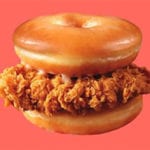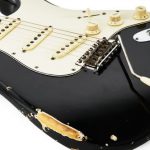 Animals
Animals  Animals
Animals  Weird Stuff
Weird Stuff 10 Weird Things People Used to Do at New Year’s
 Our World
Our World 10 Archaeological Discoveries of 2025 That Refined History
 Weird Stuff
Weird Stuff 10 Fascinating Facts You Might Not Know About Snow
 Miscellaneous
Miscellaneous Top 10 Things Crypto Was Supposed to Change & What Actually Did
 History
History 10 Huge Historical Events That Happened on Christmas Eve
 Music
Music 10 Surprising Origin Stories of Your Favorite Holiday Songs
 History
History 10 Less Than Jolly Events That Occurred on December 25
 Weird Stuff
Weird Stuff 10 Funny Ways That Researchers Overthink Christmas
 Politics
Politics 10 Political Scandals That Sent Crowds Into the Streets
 Animals
Animals 10 Species That Refused to Go Extinct
 Weird Stuff
Weird Stuff 10 Weird Things People Used to Do at New Year’s
 Our World
Our World 10 Archaeological Discoveries of 2025 That Refined History
Who's Behind Listverse?

Jamie Frater
Head Editor
Jamie founded Listverse due to an insatiable desire to share fascinating, obscure, and bizarre facts. He has been a guest speaker on numerous national radio and television stations and is a five time published author.
More About Us Weird Stuff
Weird Stuff 10 Fascinating Facts You Might Not Know About Snow
 Miscellaneous
Miscellaneous Top 10 Things Crypto Was Supposed to Change & What Actually Did
 History
History 10 Huge Historical Events That Happened on Christmas Eve
 Music
Music 10 Surprising Origin Stories of Your Favorite Holiday Songs
 History
History 10 Less Than Jolly Events That Occurred on December 25
 Weird Stuff
Weird Stuff 10 Funny Ways That Researchers Overthink Christmas
 Politics
Politics 10 Political Scandals That Sent Crowds Into the Streets
10 Bizarre Items That Hitched a Ride into Space
Humanity’s journey into space is filled with profound milestones, from landing on the moon to peering into the depths of the universe with powerful telescopes. But not all payloads launched into the great expanse are so serious or monumental. Some are downright quirky, whimsical, or even bizarre.
These oddities sent into the void often carry with them stories that are as intriguing as they are unusual, reflecting the human spirit in all its curious, playful, and inventive glory.
Related: 10 Space Myths We Believe Because Of Movies
10 Salmonella Bacteria
Salmonella bacteria, known for causing food poisoning, were sent to the International Space Station (ISS) on space shuttle missions in 2006 and 2008, leading to a surprising discovery. In the unique microgravity environment of space, these bacteria became more virulent than their Earth-bound counterparts. This finding is significant because the conditions in space are somewhat similar to those inside human intestines, where a mechanical force called fluid shear is low, just like in space. This similarity helps researchers understand how salmonella behaves inside the human body.
The research conducted in space has opened new avenues for improving food safety and developing new treatments and vaccines to fight food poisoning on Earth. It also has implications for protecting astronauts from infectious diseases during space missions. One of the key findings by Cheryl Nickerson from the Biodesign Institute at Arizona State University is that by altering the levels of ions in the environment of the bacteria, it’s possible to prevent the increase in virulence observed in space. This insight could lead to new ways to treat salmonella infections on Earth and in space.
This research is particularly crucial as NASA plans for longer space missions to the moon and Mars, where astronauts will be far from medical help and may have weakened immune systems due to microgravity, making them more susceptible to illness and infections. Understanding and combating microbial threats in space is a step forward in ensuring the health and safety of astronauts on future long-duration missions.[1]
9 A Sound Recording of Human Brainwaves
In the summer of 1977, NASA launched the Voyager Interstellar Mission, which involved sending two spacecraft into the cosmos. Each of these spacecraft carried a golden record, serving as a time capsule designed to last a billion years. The records contained sounds and music from Earth, including significant moments such as a mother’s first words to her child, a kiss, and greetings in 59 languages.
The purpose of these records was to serve as a message to any alien civilization that might come across them. The project was led by the renowned astronomer and science communicator Carl Sagan, with creative direction from Ann Druyan. During the Voyager project, Druyan and Sagan fell deeply in love and eventually got married in 1981.
One of Druyan’s ideas for the record was to include the electrical impulses of the human brain and nervous system. Shortly after their engagement, she recorded these impulses while meditating on the nature of love at Bellevue Hospital. This personal touch was intended to convey the essence of human emotion to any potential extraterrestrial discoverers.
The golden records have now traveled far beyond our solar system, moving at a speed of 35,000 miles per hour into interstellar space. They carry with them the sounds of Earth and the enduring story of a human love that transcends time and space.[2]
8 LEGO Figures
Three special LEGO figurines were sent on a journey to Jupiter aboard NASA’s Juno spacecraft in 2011. These unique LEGO Minifigures represent the Roman god Jupiter, his wife Juno, and the renowned “father of science,” Galileo Galilei. This initiative was part of the “Bricks in Space” project, a collaborative effort between NASA and the LEGO Group, aimed to inspire children to delve into science, technology, engineering, and mathematics.
Scott Bolton, the principal investigator for the Juno mission, had emphasized NASA’s long-standing partnership with LEGO and the educational benefits of the toy. The Juno spacecraft, along with the minifigures, was scheduled to reach Jupiter in July 2016, where it would orbit the planet for a year before intentionally descending into its gaseous atmosphere.
In terms of mythology, Jupiter used clouds to conceal his mischief, but Juno could see through them, revealing his true nature. The Juno spacecraft aimed to do something similar by looking beneath Jupiter’s clouds to understand its structure and history. The LEGO representation of Juno held a magnifying glass, symbolizing her quest for truth, while Jupiter held a lightning bolt. Galileo Galilei, who made significant discoveries about Jupiter, including identifying its four largest moons, was also represented with a telescope.
Interestingly, these LEGO figures were not made of plastic but of a special space-grade aluminum. They had undergone rigorous testing to ensure they were fit for the mission. Alongside these figures, a plaque honoring Galileo, made of flight-grade aluminum, was also attached to Juno. This plaque showcased a self-portrait of Galileo and included a passage he had written in 1610 about his observations of Jupiter.[3]
7 Sea Urchin Sperm
Scientists sent sea urchin eggs into space on rockets in the 1990s to see if they could still start life in zero gravity, just like they do on Earth. They found out that these eggs could indeed get fertilized and start developing into baby sea urchins even when they were floating in space. But there was something curious: If the eggs spent time in space without getting fertilized, they couldn’t start the process once they were back on Earth.
In one of the space trips in 1993, researchers looked closely to see if the very first steps of a sea urchin baby’s life, where the single egg splits into many cells, were messed up by being in space. It turns out that the tiny cells could indeed feel the lack of gravity, but they kept on growing correctly anyway. This made the scientists think that these cells might have a special way to sense gravity that’s linked to their own growth cycle.
These space trips were important because they demonstrated that rockets could be good places to study how life begins and grows, as long as the scientists pick the right moments in life’s early stages to look at. The big takeaway is that the very start of life, at least for sea urchins, doesn’t seem to be bothered by the lack of gravity.
However, scientists are still scratching their heads about what would happen if there was no gravity at all for a long time. The space eggs also got scientists thinking more critically about how gravity might play a role in the way living things grow and develop in such extreme conditions.[4]
6 A Piece of the Wright Brothers’ Airplane
In July 1969, Neil Armstrong, the first man to walk on the moon, carried with him pieces of the Wright Flyer as a tribute to aviation pioneers Orville and Wilbur Wright. These items included fabric and propeller pieces from the aircraft that achieved the first powered flight in 1903.
As the 50th anniversary of Armstrong’s lunar landing approached, and with the release of the biopic First Man, over 3,000 of Armstrong’s personal items were auctioned, including parts of the Wright Flyer. These artifacts, which Armstrong had received through an arrangement with the U.S. Air Force Museum, were part of his “personal preference kit” allowed on the lunar module. Armstrong, an Ohioan like the Wright brothers, had always admired them and studied their work extensively.
The media at the time drew comparisons between the moon landing and the Wright brothers’ flight, noting the contrast in the nature of courage required. A 1969 TIME essay reflected on how the Apollo 11 mission represented a shift from individual courage to a collective, highly organized effort, with astronauts appearing as parts of a vast system, their actions heavily monitored and supported by technology and teams. However, some saw a similarity in the transformative impact of both events on humanity’s relationship with the environment and the cosmos.[5]
5 Luke Skywalker’s Lightsaber
In October 2007, the space shuttle Discovery’s STS-120 mission carried a unique piece of cargo alongside its crew and a new module for the International Space Station: the original lightsaber prop used by Mark Hamill as Luke Skywalker in the 1977 film Star Wars. This event was part of the 30th-anniversary celebration of the iconic movie franchise.
Before its journey to space, the lightsaber was sent off in a special ceremony at Oakland International Airport in California, where it was handed over to NASA officials by Chewbacca. Other characters, including Boba and Jango Fett, were also present to see the prop off. After arriving in Houston, Texas, the lightsaber was greeted by Stormtroopers and R2-D2 and displayed at Space Center Houston before being prepared for its spaceflight.
The shuttle mission, led by commander Pam Melroy and pilot George Zamka, included a seven-person crew tasked with delivering the Harmony module to the space station. The lightsaber’s send-off and subsequent space journey were a symbolic nod to the cultural impact of the Star Wars saga, blending science fiction with real-world space exploration.[6]
4 A Tesla Roadster
In February 2018, SpaceX achieved a significant milestone by launching a Tesla Roadster into space on the maiden flight of their Falcon Heavy rocket. This event was more than just a display of the rocket’s capabilities; it was a symbolic act meant to inspire humanity, as expressed by Elon Musk, the CEO of both SpaceX and Tesla.
Musk emphasized the importance of inspiring events in making life about more than just solving problems. The Tesla Roadster, with its mannequin driver dubbed “Starman,” has been traveling on an elliptical orbit around the Sun, which it completes every 557 days. The roadster has already made its first close approach to Mars, coming within 5 million miles (8 million kilometers) of the Red Planet. The car is on a trajectory that will also bring it close to Earth, passing within 32 million miles (51.5 million kilometers).
The roadster has been orbiting for over two years and has already completed 1.75 orbits of the Sun. It’s currently traveling at a speed of about 55,000mph (34,157 km/h) and is approximately 37 million miles (59.5 million kilometers) from Earth.
Interestingly, the car has “driven” far beyond its original 36,000-mile (57.9-kilometer) warranty, metaphorically speaking, while orbiting the Sun. Eventually, the Tesla is expected to either burn up in the atmosphere of Earth or Venus, but this fiery end is not anticipated to occur for at least another 10 million years.[7]
3 A Wheel of Cheese
In 2010, SpaceX, the private spaceflight company, made a quirky leap into history by launching a large wheel of Le Brouere cheese into orbit as a secret payload during the first flight of its Dragon space capsule. This whimsical act was a nod to a classic skit from the British comedy show Monty Python’s Flying Circus, specifically a scene where John Cleese attempts to order cheese from a shop that has none.
The cheese was encased in a metal cylinder, adorned with an image reminiscent of the Top Secret! film poster featuring a cow in galoshes. SpaceX’s Dragon capsule marked a milestone by becoming the world’s first commercial spacecraft to reach orbit and return to Earth safely, completing two orbits before splashing down in the Pacific Ocean.
This event was not just a quirky footnote in space exploration history but also a demonstration of SpaceX’s innovative approach. The company is known for its reusable rocket technology, which was highlighted again when SpaceX reused an orbital rocket booster for the first time, a significant step toward more cost-effective space travel.
Musk’s tweet—uh, x-post… or whatever they’re calling them now—about the cheese payload came after this achievement and also teased the future launch of the Falcon Heavy rocket, which would feature three reusable boosters and have the capability to send a small crew to the moon.[8]
2 The Ashes of Star Trek’s Creator
In 2024, Celestis, a company that offers space burials, will launch a pioneering deep space mission carrying nearly 200 capsules of cremated remains and DNA samples, including those of Star Trek creator Gene Roddenberry, his wife Majel Barrett Roddenberry, and their son Eugene “Rod” Roddenberry’s DNA. This mission, named the Voyager Memorial Spaceflight, will send the remains and DNA on a journey to permanently orbit the Sun, marking a new chapter in space burials.
Majel Barrett Roddenberry, known as “The First Lady of Trek,” was an actress in the original Star Trek series and the voice of the USS Enterprise’s computer in the series and movies. The mission will also carry the remains of other Star Trek cast members, such as James Doohan (“Scotty”), Nichelle Nichols (Lt. Uhura), and DeForest Kelley (“Bones”).
The launch, conducted by United Launch Alliance, will take place at Cape Canaveral, Florida, and will be part of a three-day memorial event. The Vulcan Centaur rocket will propel the capsules into space, where they will travel past the Earth-Moon system and the James Webb telescope to become part of the Enterprise Station, the most distant permanent human repository outpost orbiting the Sun.
Celestis provides a real-time tracking tool for families and friends to monitor the journey of their loved one’s remains through space. This mission is seen as a way for individuals to leave a lasting legacy and to be part of an “ultimate road trip” into the cosmos.[9]
1 A Corned Beef Sandwich
NASA astronaut John Young, remembered for his significant contributions to the U.S. space program, also left behind a quirky legacy involving a corned beef sandwich. On March 23, 1965, during the Gemini 3 mission, Young smuggled the sandwich into space by hiding it in his pocket. This mission was notable for being the first U.S. spaceflight to carry two astronauts, Young and Gus Grissom, and occurred amid a tense period in the Space Race, just after the Soviets had launched a two-person mission of their own.
The presence of the sandwich was revealed during a brief exchange between Young and Grissom, captured in the mission’s transcript. Grissom decided to stow the sandwich away after noticing it was crumbling, which could have posed a risk to the spacecraft’s operations. This incident, though minor, caught the attention of U.S. politicians and led to a review by the House of Representatives Committee on Appropriations, where concerns were raised about the potential dangers of loose crumbs in a spacecraft.
NASA officials, including Administrator James Webb, were called to testify, and measures were taken to prevent such an occurrence in the future. Despite the controversy, the sandwich incident is often looked back upon with a sense of humor. It even led to corned beef being officially included on the menu of the first space shuttle mission in 1981, which Young also commanded.
Today, astronauts are still making sandwiches in space, but they use tortilla bread to minimize crumbs. The corned beef sandwich episode is memorialized with a replica on display at the Grissom Memorial Museum in Indiana, serving as a lighthearted footnote in the history of space exploration.[10]








